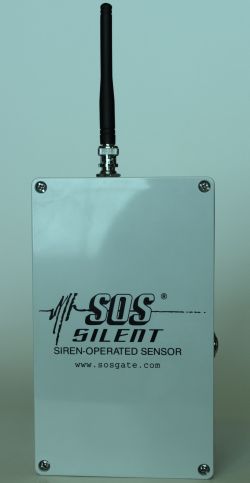When officers of the Dunwoody Police Department, in Georgia, respond to calls in their city, there is a good chance that the individual in need of help will live in one of the area’s 30-plus gated communities. Until now, an officer needed to refer to a list of access codes, find the numerical code for a specific locked gate, and enter that code manually into the gate’s keypad. Often they found that the gate’s access code had been changed but the list had not been updated accordingly. Therefore, while a victim of a medical emergency, domestic violence or a robbery may be awaiting assistance, officers have needed to get creative to gain entrance through the gate, says Timothy Fecht, the Dunwoody police department’s public information officer.
The solution to the problem is being installed in all gated communities in Dunwoody, in observance of the city’s new Emergency Vehicles Access to Gated Communities ordinance, which requires the installation of an active RFID system known as SOS Silent. The technology, provided by a company called Siren Operated Sensor (SOS), ensures officers can gain entrance automatically via a battery-powered RFID tag in their vehicle, and a receiver integrated in the gate locking system.
Fecht says the problem came to the attention of the city council when Dunwoody Councilmember Terry Nall spent a day accompanying officers on their rounds. Nall noticed that the community gates were in some cases causing delays in emergency response while officers searched for the proper access code. Often, Fecht says, the communities will change access codes, for instance when they hire a new gate management company, and they don’t always let police know when those access codes change. To gain entrance, officers waiting at a closed gate have needed to flag down assistance from a nearby resident, or even randomly dial phone numbers of residents inside, asking them to unlock that barrier.
In March, the city council passed an ordinance requiring the adoption of an RFID and sound-based sensor system, and the police department met with gated community members to strike a deal: The department would purchase the tags and receiving devices from SOS, and each community would be responsible for installing them. Thus far two gated communities have installed the receivers at their gates in the past few weeks, while others are in the process of doing the same.
SOS was launched in the 1960s as a sound-based sensor solution to access locked gates, says the company’s president and owner, McKay Lundgren. The founder of the company, Lundgren’s father-in-law, Wayne Skeem, was an Idaho farmer who designed a system that would release the locking mechanism of a gate to an agricultural area, such as a field, in response to a car horn. The product was known as Horn Gate. In the 1980s Skeem’s company introduced a version designed to open a gate when it detects an emergency vehicle’s siren at 100 decibels for at least 2.8 seconds. In that way, when an emergency vehicle arrives at the gate with its siren blaring, the gate will open for that vehicle.
Lundgren says the company has sold about 30,000 such devices in the United States and abroad. However, he says, in some cases police might want a solution that accommodates a quiet approach. They may not want to arrive at a gate with their sirens switched on, and instead might be doing routine patrols or be responding to a call without sirens. Therefore Dunwoody opted for the newly released SOS Silent product, which detects not only sirens but also RFID tags, making the city the first customer to use the hybrid system, according to Lundgren. The RFID technology consists of customized versions of 1st Choice Security’s R2000 readers and T8000 tags.
The SOS Silent system’s active 433 MHz tag is attached behind a vehicle’s front bumper. Every few seconds, it uses a proprietary air-interface protocol to beacon a unique ID that can be captured at a distance up to 150 feet. To prevent erroneous readings when a police vehicle might merely be passing the gate but not trying to gain entrance, the read range can be dialed down to just a few feet. The tag’s battery lasts for approximately five years of operation, after which the tag is replaced.
The Dunwoody Police Department has tags installed in its 50 patrol cars, and is now exploring whether the city can also provide tags to about six fire vehicles that cover the same area, Fecht explains. The receiver, which contains a sound sensor and an RFID reader with an omni- or uni-directional antenna, is typically placed in an enclosure on the gate and wired to a gate’s opening mechanism.
At least two Dunwoody communities have contacted SOS about purchasing more tags to be provided to its residents, says Lundgren. In that scenario, the tag could be placed in a glove compartment or even a resident’s pocket or purse, and its beacon would be captured by the reader when the car approached a gate. However, Lundgren says, this function will require some redevelopment work on the receiver. The system would need one receiver to be able to detect transmissions from both emergency and resident vehicles, but respond uniquely to them: An emergency vehicle’s tag could be used to open any gate to any community within the city, while a resident’s tag would be permitted to open only the gates to his own community.
The police department in Dunwoody is paying about $600 for each receiver, while the community pays about $500 to hire a technician to install the receiver. The receiver’s price varies according on the volume purchased, says Lundgren, but typically one receiver could be purchased for less than $1,000, while tags cost about $25 apiece.
The Dunwoody ordinance allows communities until March 2016 to comply. Fecht says he lives in one of the two communities that have already gone live with the technology, and it works well when he drives through the gate with a police vehicle. “It’s all about reducing the amount of time it takes us to respond to a call,” he says.




